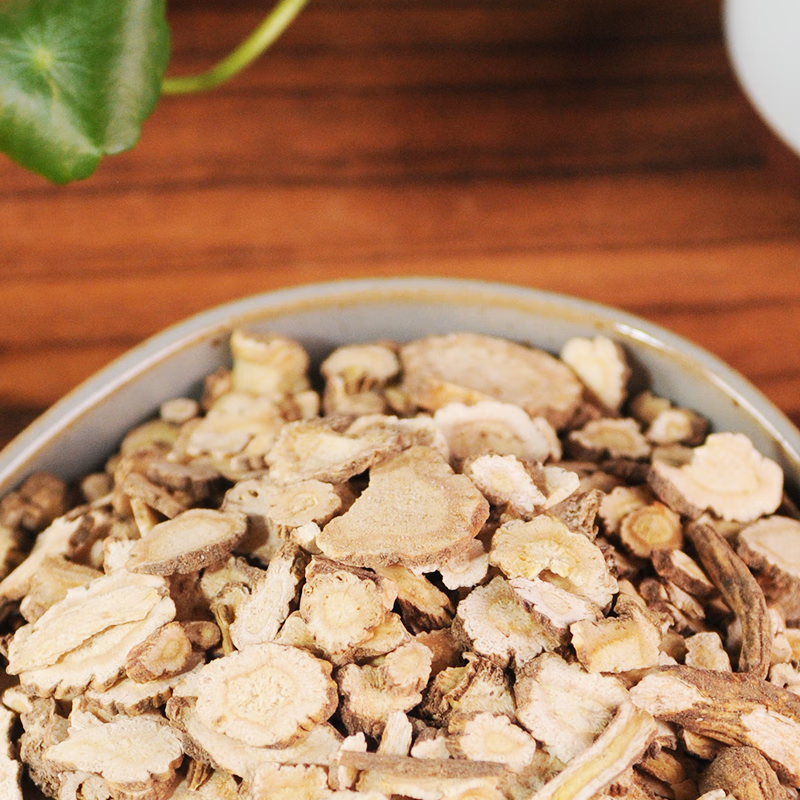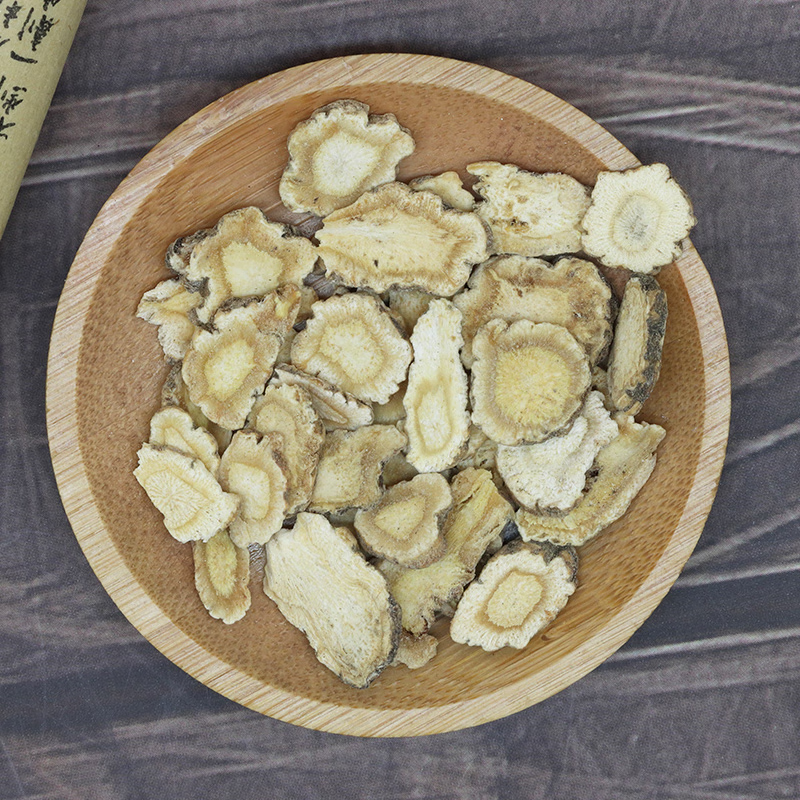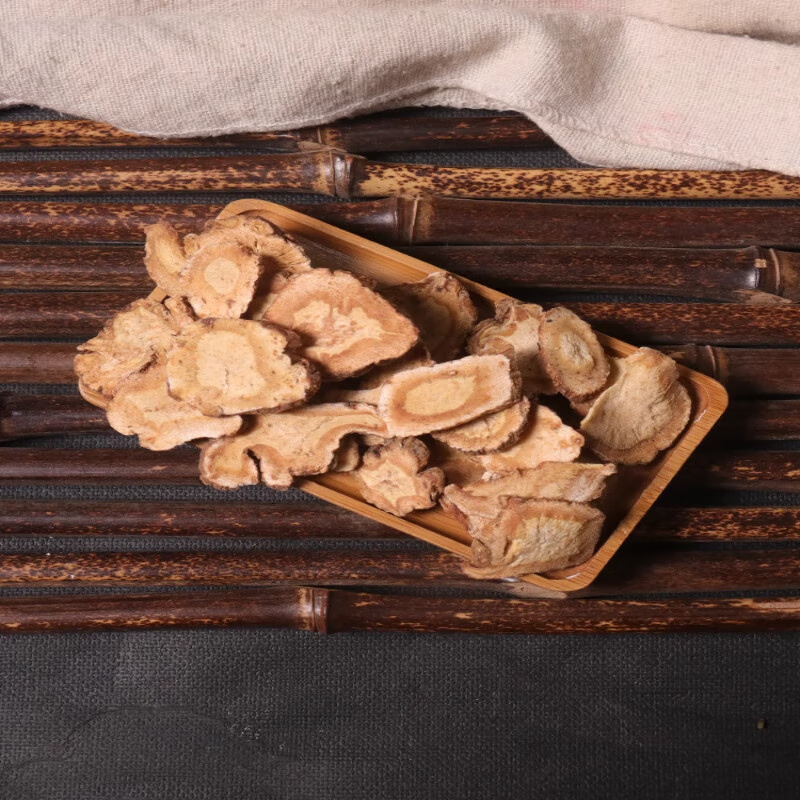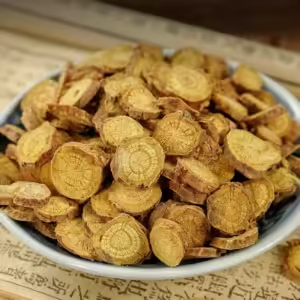Qian hu – Peucedanum chinense,PEUCEDANIRADIX,qian hu herb,qian hu tcm,Peucedanum chinense
[Medicinal use] This product is the root of white flower Peucedanum chinense or purple flower Peucedanum chinense of the Umbelliferae family.
[Nature and flavor and meridians] Bitter, pungent, slightly cold. Enters the lung meridian.
[Effects] It descends qi and resolves phlegm, dispels wind and heat.
[Clinical application] It is used for symptoms such as lung qi not descending, thick phlegm and wheezing, uncomfortable expectoration, wind-heat stagnation in the lung, cough and phlegm.
Peucedanum chinense is pungent and bitter, has a slight power to disperse wind, and is good at descending qi and resolving phlegm. Therefore, it is suitable for symptoms such as lung qi not descending, the order of clearing and purging is not working, thick phlegm and wheezing, and uncomfortable expectoration. It is often used in combination with mulberry bark, perilla seed, almond and other medicines; as for the treatment of wind-heat stagnation in the lung, cough and phlegm, it can be used with mint, burdock seed, platycodon and other products.
[Prescription name] Young Peucedanum chinense, powdered Peucedanum chinense, Peucedanum chinense (wash, dry, slice for use), roasted Peucedanum chinense (honey roasted for moistening the lungs, descending qi and resolving phlegm)
[General dosage and usage] One to three qian, decocted and taken.
[Comments] 1. Both Peucedanum chinense and Radix Bupleuri can reduce qi and resolve phlegm, but Peucedanum chinense can also dissipate wind-heat, while Radix Bupleuri is specialized in reducing qi.
2. Both Peucedanum chinense and Radix Bupleuri have dispersing power, and the two herbs can be used together to disperse wind and relieve heat, so the predecessors called the two hu as wind medicine. However, Peucedanum chinense treats the lung meridian and mainly descends, while Radix Bupleuri treats the liver and gallbladder and mainly ascends, which is the difference between the two herbs.
[Example of prescription] Peucedanum chinense powder “Zhengzhi Zhunsheng”: Peucedanum chinense, Morus alba, Fritillaria, Radix Ophiopogonis, Licorice. Treats cough, thick and sticky mucus, chest discomfort, and occasional irritability.
This product is the dried root of Peucedanum praeruptorum Dunn, a plant of the Umbelliferae family.
Dig up in winter to the next spring when the stems and leaves wither or when the flower stems have not yet emerged, remove the fibrous roots, wash, and dry in the sun or at low temperature.
[Properties]
This product is irregularly cylindrical, conical or spindle-shaped, slightly twisted, often with branches at the bottom, 3~15cm long, 1~2cm in diameter, dark brown or grayish yellow on the surface, with many stem scars and fibrous sheath residues at the root head, dense fine ring patterns at the upper end, longitudinal grooves, longitudinal wrinkles and transverse lenticel-like protrusions at the lower part. The texture is relatively soft, the dry ones are hard and can be broken, the cross section is uneven, light yellow-white, the cortex is scattered with many brown-yellow oil spots, the cambium ring patterns are brown, and the rays are radial. The smell is aromatic, and the taste is slightly bitter and pungent.
[Identification]
(1) Cross-section of this product: The cork layer is composed of 10 to more than 20 rows of flat cells. The oil tubes near the inner layer of the cork are sparsely arranged in a wheel. The phloem is wide, with many cracks of varying sizes visible on the outside; there are many oil tubes, which are round and scattered, and the phloem rays are mostly curved near the cortex. The cambium is annular. The large and small vessels of the xylem are arranged alternately; the wood rays are 2 to 10 rows of cells wide, with scattered oil tubes; wood fibers are rare. The thin-walled cells contain starch granules.
(2) Take 0.5q of the powder of this product, add 10ml of chloroform, ultrasonically treat for 10 minutes, filter, evaporate the filtrate, and add 5ml of methanol to dissolve the residue as the test solution. Take the white flower peucedanum A reference substance and the white flower peucedanum B reference substance, add methanol to make a mixed solution containing 0.5mg of each per 1ml, as the reference solution. According to the thin layer chromatography method (General Rule 0502), 5μl of each of the above two solutions are respectively spotted on the same tridacna G thin layer plate, and petroleum ether (60~90℃)-ethyl acetate (3:1) is used as the developing agent. Develop, take out, dry, and examine under ultraviolet light (365nm). In the chromatogram of the test sample, at the corresponding position of the chromatogram of the reference sample, a light spot of the same color appears.
【Inspection】
The water content shall not exceed 12.0% (General Rule 0832 Method 2).
Total ash shall not exceed 8.0% (General Rule 2302)
Acid-insoluble ash shall not exceed 2.0% (General Rule 2302)
【Extract】
Determine according to the cold leaching method under the alcohol-soluble extract determination method (General Rule 2201), using dilute ethanol as the solvent, and shall not be less than 20.0%.
【Content determination】
Determine according to the high performance liquid chromatography method (General Rule 0512). Chromatographic conditions and system suitability test: Octadecyl tridane bonded tridacna gum was used as filler: methanol-water (75:25) was used as mobile phase: detection wavelength was 321nm, and the theoretical plate number was calculated based on the peucedanum praeruptorin A peak and should be no less than 3000.
Preparation of reference solution: Take appropriate amount of peucedanum praeruptorin A reference substance and peucedanum praeruptorin B reference substance, weigh them accurately, and add methanol to make a mixed solution containing 50ug of each per 1ml.
Preparation of test solution Take about 0.5g of the powder of this product (passed through No. 3 sieve), weigh accurately, place in a stoppered conical flask, accurately add 25ml of chloroform, seal, weigh, ultrasonically treat (power 250W, frequency 33KHz) for 10 minutes, cool, weigh again, make up the lost weight with chloroform, shake well, filter: accurately measure 5ml of the filtrate, evaporate to dryness, dissolve the residue in methanol and transfer to a 25ml volumetric flask, add methanol to the scale, shake well, and obtain.
Determination method: accurately aspirate 10u of the reference solution and the test solution respectively, inject into the liquid chromatograph, and determine.
This product, calculated on the basis of dry product, contains not less than 0.90% of peucedanum praeruptoside A (C21H2207) and not less than 0.24% of peucedanum praeruptoside B (C24H2607).
Medicinal pieces
[Processing]
Huang Hu Remove impurities, wash, moisten, slice thinly, and dry in the sun.
[Properties]
This product is in the form of quasi-circular or irregular slices. The outer skin is dark brown or grayish yellow, and sometimes residual fibrous leaf sheath residues can be seen. The cut surface is yellowish white to light yellow, and there are many brownish yellow oil spots scattered on the skin, and brown rings and radial textures can be seen. The smell is fragrant, and the taste is slightly bitter and pungent.
[Inspection]
The total ash content is the same as the medicinal material, and shall not exceed 6.0%.
[Identification]
(Except for cross-section)
[Inspection]
(Water content)
[Extract]
[Content determination]
Same as the medicinal material.
Honeyed Huang Hu Take Huang Hu slices and stir-fry them according to the honey roasting method (General Rule 0213) until they are not sticky.
[Properties]
This product is shaped like Huang Hu slices, with a yellowish brown surface, slightly shiny, and moisturizing. The taste is slightly sweet.
[Inspection]
The water content is the same as the medicinal material, and shall not exceed 13.0%.
【Identification】
(Except cross section)
【Inspection】
(Total ash, acid insoluble ash)
【Extract】
Content determination】
Same as medicinal material.
【Nature and flavor and meridians】
Bitter, pungent, slightly cold. Enters the lung meridian
【Function and indications】
Descends qi and resolves phlegm, dispels wind and clears heat. Used for phlegm-heat wheezing, yellow and thick sputum, wind-heat cough with sputum.
【Usage and dosage】
3~10g.
【Storage】
Put in a cool and dry place to prevent mold and moth.
Where is the main origin of Peucedanum praeruptorum Dunn?
Distributed in Gansu, Henan, Guizhou, Guangxi, Sichuan, Hubei, Hunan, Jiangxi, Anhui, Jiangsu, Zhejiang, Fujian, China.
Where is the main medicinal part of Peucedanum praeruptorum Dunn?
Medicinal part of Peucedanum praeruptorum Dunn: This product is the dried root of Peucedanum praeruptorum Dunn, a plant of the Umbelliferae family. Dig up when the stems and leaves wither or flower stems do not emerge from winter to the next spring, remove the fibrous roots, wash, and dry in the sun or at low temperature.
Characteristics of the medicinal parts of Peucedanum chinense:
This product is irregularly cylindrical, conical or spindle-shaped, slightly twisted, often branched at the bottom, 3~15cm long, 1~2cm in diameter. The surface is dark brown or grayish yellow, with stem scars and fibrous sheath residues at the root head, dense fine ring patterns at the top, longitudinal grooves, longitudinal wrinkles and transverse lenticel-like protrusions at the bottom.
The texture is relatively soft, the dry ones are hard, can be broken, the cross section is uneven, light yellow-white, the cortex is scattered with many brown-yellow oil spots, the cambium ring patterns are brown, and the rays are radiating. The smell is fragrant, and the taste is slightly bitter and spicy.
How are peucedanum recorded in ancient books?
“Famous Doctors’ Records”: “It is mainly used to treat phlegm, chest and ribs, abdominal qi, wind headache, phlegm and lower qi. Treat cold and heat in typhoid fever.
“Materia Medica”: “It can remove heat and heat, and treat both internal and external heat in time.
“Compendium of Materia Medica Volume 13”: “Clear lung heat, resolve phlegm and heat, and disperse wind evil.
“Benjing Fengyuan”: “It is good at lowering qi, so it can treat phlegm-heat wheezing and cough, diaphragmatic diseases, and fire will be lowered when qi is lowered. Phlegm is also lowered, which is the key flavor of phlegm and qi, and it can treat cold and heat in typhoid fever and both internal and external heat in time.
Effects and functions
Pucedanum has the effects of lowering qi and resolving phlegm, dispersing wind and clearing heat.
What are the main effects and clinical applications of peucedanum?
Pucedanum is used for phlegm-heat wheezing, yellow and thick sputum, and wind-heat cough with a lot of sputum.
Phlegm-heat or wind-heat cough
Treats phlegm-heat blocking the lungs, asthma and chest fullness caused by lung failure to descend, and yellow and thick sputum. It is often used with almonds, mulberry bark, and Fritillaria. .
·For cough and sputum caused by wind-heat blocking the lungs, it is often used with mulberry leaves, burdock seeds, and platycodon.
What other effects does Peucedanum have?
In my country’s traditional food culture, some Chinese medicinal materials are often widely consumed as food ingredients by the people, that is, materials that are both food and Chinese medicinal materials according to tradition (i.e. edible medicinal substances). According to the documents issued by the National Health Commission and the State Administration for Market Regulation, Peucedanum can be used as both medicine and food within a limited range of use and dosage.
The commonly used medicinal diet recipes for Peucedanum are as follows:
·Erqian tea: 5g Baiqian, 3g Peucedanum, and 3g scented tea. Brew with 250ml of boiling water and drink until the taste is light.
·Jiqian tea: 5g Platycodon, 3g Peucedanum, and 3g green tea. Brew with 250ml of boiling water and drink until the taste is light.
·Clearing lung and cough tea: 29g of Trichosanthes peel, 1.59g of Peucedanum chinense, 1.59g of Scutellaria baicalensis, 29g of Platycodon grandiflorum, 3g of Licorice, and 5g of Green Tea. Use 400ml of water to decoct the first four herbs, and brew the licorice and green tea for 5-10 minutes. It can also be brewed with boiling water and then drunk.
Note: The use of Chinese herbal medicines must be based on syndrome differentiation and treatment, and should be used under the guidance of professional Chinese medicine practitioners. Do not use them at will, and do not listen to Chinese medicine prescriptions and advertisements at will.
What are the compound preparations containing Peucedanum chinense?
Xingsu Powder
It is light and cool, regulates the lungs and resolves phlegm. It is mainly used to treat exogenous cold and dryness syndrome. Aversion to cold and no sweat, slight headache, cough with thin sputum, nasal congestion and dry throat, white fur and stringy pulse.
Suzi Jiangqi Pills
It reduces qi and resolves phlegm, warms the kidney and absorbs qi. It is used for cough, wheezing, and chest and diaphragm obstruction caused by upper fullness and lower deficiency, qi reversal and phlegm congestion.
Xiaoer Jindan Tablets
It dispels wind and resolves phlegm, clears heat and detoxifies. Used for colds caused by exogenous wind-heat and internal phlegm-fire, with symptoms of fever, headache, cough, asthma, sore throat, vomiting, and high fever and convulsions.
Shensu Pills
Replenishing Qi and relieving exterior symptoms, dispelling wind and cold, and removing phlegm and relieving cough. Used for colds caused by physical weakness and wind-cold, with symptoms of aversion to cold and fever, headache and nasal congestion, cough and sputum, chest tightness and vomiting, fatigue and shortness of breath.
Chuanbei cough syrup
Relieves cough and removes phlegm. Used for wind-heat cough, phlegm and shortness of breath or dry cough.
Modern research progress on peucedanum
This product has multiple pharmacological effects such as expectoration, asthma relief, cough relief, fever relief, anti-inflammatory, analgesia, anti-myocardial ischemia, anti-arrhythmia, inhibition of platelet aggregation, and improvement of microcirculation.
Usage
Pucedanum is generally used for decoction.
How to use peucedanum correctly?
When peucedanum decoction is taken orally, the usual dosage is 3~10g.
Through different processing methods, Chinese medicinal materials such as peucedanum and honey peucedanum can be produced. Different preparation methods have different effects, but the method of use is the same. Please follow the doctor’s instructions for specific use.
Peucedanum chinense is generally used in decoctions, decocted and taken, or made into powder or pills. However, the use of Chinese medicinal materials must be treated according to syndrome differentiation and should be used under the guidance of professional Chinese medicine practitioners. Do not use them at will, and do not listen to Chinese medicine prescriptions and advertisements at will.
How to prepare Peucedanum chinense?
Peucedanum chinense: Take the original medicinal materials, remove impurities and residual stems, wash, moisten, cut into thin slices, dry, and remove debris. . Honey Peucedanum chinense: Take refined honey and dilute it with an appropriate amount of boiling water, pour it into the Peucedanum chinense slices, mix well, moisten until the honey liquid is absorbed, put it in a frying container, heat it over a low heat, fry until it is not sticky, take it out, and let it cool. For every 100kg of Peucedanum chinense slices, use 25kg of refined honey.
What drugs should be used with Peucedanum chinense at the same time?
The combined use of Chinese medicine and the combined use of Chinese and Western medicines require syndrome differentiation and treatment, and clinical individualized treatment.
If you are taking other medications, please consult a doctor before taking the medicine, and inform the doctor of all your confirmed diseases and treatment plans you are receiving.
Medication Instructions
Purple radix chinensis is bitter, pungent, and slightly cold, so people with yin deficiency cough, cold drink cough and asthma should be careful when taking it.
What precautions should be taken when using purple radix chinensis?
· People with yin deficiency cough and cold drink cough should be careful when taking it.
This product has a fragrant smell and tastes slightly bitter and pungent. The cut surface is light yellow and white, and the aroma is strong. It is best to use it raw or honey roasted.
During the medication period, you should be careful not to eat cold, raw and cold food, spicy and greasy food, and avoid smoking and drinking.
Pregnant and lactating women: If you are pregnant, planning to become pregnant, or are lactating, please inform your doctor in time and consult whether Chinese medicine can be used for treatment.
· Children: Children’s medication must be taken under the guidance of a doctor and adult supervision.
· Please properly store the medicinal materials and do not give your own medicinal materials to others.
Avoid using copper or iron utensils to decoct medicine. .
How to identify and use Peucedanum chinense?
White Peucedanum and Peucedanum chinense
Both can descend qi and resolve phlegm, treat lung qi reversal, cough, asthma and excessive sputum, and are often used together.
·However, White Peucedanum chinense is pungent, pungent and slightly warm, focusing on descending qi, resolving phlegm and relieving asthma, with a strong expectorant effect, and is often used for internal cold, phlegm, cough and asthma; Peucedanum chinense is slightly cold, and can also dispel wind and heat, and is often used for exogenous wind-heat or phlegm-heat cough and asthma.
Peucedanum chinense and Bupleurum
Both are from the Umbelliferae family, and are called “Erhu”, both have the function of dispersing wind and heat, and treat exogenous wind-heat syndrome.
However, Peucedanum chinense is pungent, dispersing, bitter and descending, and is good at descending qi and resolving phlegm, and is good at treating phlegm-heat cough and asthma, and excessive sputum with yellow color.
Bupleurum chinense is pungent, bitter and purgative, and belongs to the liver meridian. It is good at regulating liver qi, which can both relieve liver depression and raise yang qi. It is suitable for liver depression and qi stagnation, qi deficiency and sinking, and organ prolapse.
Medication Tips
The most frequently asked questions by patients
Q
Is Peucedanum praeruptorum toxic?
Peucedanum praeruptorum is not toxic. Peucedanum praeruptorum is a phlegm-resolving, cough-relieving and asthma-relieving medicine. It is the dried root of the Umbelliferae plant Peucedanum praeruptorum Dunn.
Peucedanum praeruptorum is bitter, pungent and slightly cold in nature. It belongs to the lung meridian. This product mainly contains coumarin ingredients, such as Peucedanum praeruptorum A, B, C and D. It also contains saponins and volatile oils. It has the effects of descending qi and resolving phlegm, dispersing wind and clearing heat. It is used for hot asthma, yellow and thick cough, and wind-heat cough with a lot of phlegm.
Effects and functions of Xingsu Powder
·Xingsu Powder is a dryness-treating agent. It has the effects of lightly dispersing coolness and dryness, regulating the lungs and resolving phlegm. It is mainly used to treat exogenous cold syndrome.
·Symptoms include aversion to cold without sweating, slight headache, cough with thin phlegm, stuffy throat and dryness, white fur and stringy pulse.
It is clinically used to treat upper respiratory tract infection, chronic bronchitis, emphysema and other symptoms of exogenous cold and dryness (or mild exogenous wind-cold syndrome), lung failure to descend, and phlegm and dampness blocking the body.


















Reviews
There are no reviews yet.